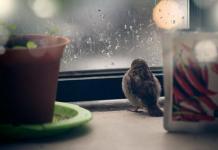Pelargonium (geranium) is a fairly popular plant among many people. They decorate not only flower beds and garden plots, but also window sills in houses.
Growing it is not so difficult; it can be propagated not only by shoots, but also by seeds.
Seeds are a simple process; this requires knowledge of some rules.
If you are going to sow pelargonium with seeds, then first of all you need to choose a quality one. planting material. Geranium has many varieties, differing in the color of the flowers, the shape of the bush and inflorescences. The seeds of this plant are sold in specialized flower shops and markets. You can also order online.
When purchasing material for flower propagation, you need to know certain subtleties. Pelargonium seeds are sold in several types and you should know about this:

One of best views The ones that gardeners prefer to use to grow are the first two species. They have good germination and are more resistant to various diseases.
Despite the fact that seeds that have not been processed are cheaper, it is better to give preference to processed types, especially for beginners in this business who are going to grow a plant for the first time.
If you still have to plant unprocessed grains, it is recommended to either soak them in warm water for a while, or rub them a little with sandpaper so that you can remove a little top layer.
When to plant geraniums: the best time to plant
After purchasing the seeds, you can start planting and try to grow the first seedlings. Experienced flower growers They don’t talk about the best time to plant a plant and believe that it can be done at any time. Just keep in mind that if planting and propagation is done in winter, the sprouts will need additional lighting.
However, it is better to plant pelargonium from November to April. Gradually, as the plant grows, daylight hours will increase. When planting is done closer to February, seedlings appear as the daylight hours and accordingly, as they grow, additional lighting is no longer required, which greatly simplifies the whole process. In addition, when planting or propagating at the very beginning of the spring, in the summer you can already expect flowering from the bushes.
Having decided on the landing time, you need to think about the location. Good for this wooden boxes, which need to be filled with substrate. The substrate may consist of mixtures of several components. Good for geraniums:
- sandy soil, turf, peat in a ratio of 1:2:1;
- peat soil and in a 1:1 ratio;
- sandy soil and peat soil - also taken in a 1:1 ratio.
 Pelargonium seeds are placed on the surface of the soil. In this case, a distance of approximately 5 cm should be maintained between each grain so that during germination the seedlings do not interfere with each other’s growth. The grains are sprinkled with a thin layer of soil on top and sprayed with pre-settled water from a spray bottle. After this procedure, a greenhouse effect should be created in the container, for which its surface is covered with film. Then you will need to monitor the soil from above, not letting it dry out, but also not flooding it.
Pelargonium seeds are placed on the surface of the soil. In this case, a distance of approximately 5 cm should be maintained between each grain so that during germination the seedlings do not interfere with each other’s growth. The grains are sprinkled with a thin layer of soil on top and sprayed with pre-settled water from a spray bottle. After this procedure, a greenhouse effect should be created in the container, for which its surface is covered with film. Then you will need to monitor the soil from above, not letting it dry out, but also not flooding it.
During this period, it is better for the container to be in a bright place, but where the direct rays of the sun will not reach. The temperature should not be below 18 degrees and above 25. Subject to optimal conditions And good care Shoots should begin to appear in about two weeks.
What you need to know about picking geranium seedlings and how to grow them
One of the important stages in the process of seed production is picking. It is also mandatory during plant growth. Picking seedlings is transplanting them from a common container into separate containers (pots).
 Geranium seedlings are picked approximately when the sprouts acquire at least two formed leaves. It is better to carry out picking directly into separate containers. For this purpose, one of the bushes is carefully taken and its roots are divided into several independent seedlings. The main thing is not to miss the right moment in the upcoming picking, otherwise it will be very difficult to untangle the horses of the plants.
Geranium seedlings are picked approximately when the sprouts acquire at least two formed leaves. It is better to carry out picking directly into separate containers. For this purpose, one of the bushes is carefully taken and its roots are divided into several independent seedlings. The main thing is not to miss the right moment in the upcoming picking, otherwise it will be very difficult to untangle the horses of the plants.
The diameter of the container for the upcoming transplant must be at least twelve centimeters so that the pelargonium feels comfortable. It is better to water transplanted geraniums using a watering can that has a thin spout.
On days when it is raining and cloudy outside, it is better to install additional lighting above the seedlings when growing. If they don't get enough light, this will cause the leaves to begin to die. If affected leaves begin to appear, it is better to remove them immediately. As a result, this can be prevented various diseases and fungi.
After completing the picking stage, as the plant grows, a special substrate should be added to the container, which can be purchased at a specialty store.
When the seedlings already have 6-8 leaves, they will need to be pinched so that the plant does not grow too much.
How to properly care for geraniums: what they like and what they don’t
To grow, you need to know some of the subtleties of flower care. It is necessary to properly care for it from the first days. Although the plant living at home is quite unpretentious, you should still be aware of some rules:

How to understand what a plant is doing proper care? This is quite easy to do. There are several signs that help determine whether your pelargonium is receiving proper care at home. For example, if a flower has redness on its leaves, this may mean that the room is too low temperature and you should make it a little higher. If the leaves begin to turn yellow, you need to water the geranium a little more often, but if the leaves, on the contrary, darken, then you should water the plant less often. In the second case, it may be better to remove the bush immediately, because it may rot. In addition, another sign of overwatering is the appearance of mold on the leaves.
 When is abscission noted? lower leaves, this may mean that the plant does not have enough lighting at home. Thus, the house is not so complicated and consists of moderate and timely watering, not too frequent fertilization, removing diseased leaves, dry inflorescences or dry leaves. If you follow these simple rules care for the flower, the result will be good and the geranium will definitely please the grower with lush and long flowering.
When is abscission noted? lower leaves, this may mean that the plant does not have enough lighting at home. Thus, the house is not so complicated and consists of moderate and timely watering, not too frequent fertilization, removing diseased leaves, dry inflorescences or dry leaves. If you follow these simple rules care for the flower, the result will be good and the geranium will definitely please the grower with lush and long flowering.
How can you protect homemade geranium from diseases?
Unfortunately, in some cases the plant may become diseased. This happens for a number of reasons, not only when growing outdoors, but also at home. For example, various pests can cause flower disease. These could be ants, aphids or caterpillars. Geranium is very afraid of them.
Aspirin can be used to control such pests. He is universal remedy, which can be used for almost any type of pest. To kill pests with aspirin, you need to take one tablet and dilute it in one liter of water. This solution must be sprayed on the roots three times a week.
Another pest control product is Marathon, which is good at getting rid of aphids or whiteflies. It's quite easy to use. IN flower pot several granules of the drug are poured in and then the plant is watered with water.
To eliminate caterpillars, use Monterey. The product is prepared according to the instructions, after which the affected geranium bushes are sprayed.
However, it is better to prevent any disease than to treat it later, so experienced flower growers recommend prevention using the drug Messenger. It is able to increase the immunity of not only geraniums, but also other plants, and therefore protect them from all kinds of pests and diseases.
Pelargonium or geranium is perennial, which is usually grown as indoor flower and which does not particularly bother you with self-care. Previously, geranium could be found in almost every house on the windowsill. Nowadays, planting pelargonium in open ground, because on fresh air you can create much more lush flower beds that will look very beautiful and rich. Our article will discuss how to grow pelargonium for seedlings, successfully care for it at home, as well as when and how to plant it in open ground.
Naturally, the most common way to propagate pelargonium is to grow it from cuttings.

For detailed and visual information on how to propagate geranium from cuttings, see the following video.
Video: propagation of geraniums by cuttings
Now on sale you can find truly a huge number of varieties and hybrids geranium seeds, variety of colors and sizes which can satisfy any desires and needs.

By the way! If you are going to grow geranium in open ground, then it is better to buy special varieties that have medium-sized, strong and hard leaves, and these are zonal geranium, ivy-leaved geranium, etc.
When to sow pelargonium seeds for seedlings
Theoretically, you can sow geraniums for seedlings all year round, but it is more practical to sow pelargonium seeds in the second half of winter, since as your seedlings grow, the daylight hours will increase.
Thus, optimal time sowing pelargonium seeds for seedlings is January-February (maximum in March), because It will begin to bloom only after 5-6 months, just in time for summer.
Worth understanding! For growing in room conditions, if you have the opportunity to provide additional lighting, then, of course, you can sow pelargonium with seeds at any time. But if you are planning to plant in open ground, then in winter or, at most, in early spring.
In principle, you can sow even in November-December, then it will bloom in the spring - in April-May.
Important! If you sow in winter or early spring, then seedlings are a must add additional illumination, because she needs 12 hours of daylight.
Video: when and how to sow pelargonium (geranium) with seeds
How to sow pelargonium seeds correctly
So that the growth and development of pelargonium seedlings goes to in the right direction, you must select the appropriate container, suitable soil and properly prepare the seeds for planting.
Selecting a landing container
Planting containers are selected based on your capabilities and needs, as well as the number of seeds of future seedlings.
If you plan to pick, you can sow in general containers, for example, in the same plastic containers(5-6 cm high).

If it is more convenient for you to grow without picking, then pelargonium seeds can be immediately sown in individual and relatively deep containers, for example, pots or cups (8-10 cm high). Naturally, they must have drainage holes to drain excess liquid so that the water does not stagnate.
Important! If you take shallow cassettes, you will still need to transfer the seedlings from them.

If you want your pelargonium to bloom in a pot, then it must be at least 1 liter in volume.
Suitable soil
The soil for growing pelargonium seedlings should be loose and nutritious, as well as neutral in acidity. Therefore, any universal soil for growing flowers will suit you perfectly, but in general, it is ideal to take a special soil for geraniums.

It’s very good if you prepare your own substrate, which will consist of turf land, peat and sand in a ratio of 2:1:1. Instead of sand, you can use perlite or vermiculite.
Advice! To make the soil loose and soft before sowing, it can be passed through a sieve.
Seed preparation
Many gardeners quite successfully sow their seeds without any treatment, simply dry them in moist soil. But to increase germination, they should be scarified or soaked.
Pelargonium seeds can be scarified using sandpaper, in other words, slightly damage the shell so that it is easy for the sprouts to adhere. However, this must be done very carefully, otherwise you will easily spoil your seeds.
Or you can simply soak them in cotton pads in a solution (some soak them in a 3% hydrogen peroxide solution) for 20-30 minutes, in addition, this will also disinfect them.
Interesting! Pelargonium seeds come in 3 types - already scarified (i.e., cleared of the hard shell), coated and ordinary. Naturally, the first 2 types do not need to be prepared in any way; they can be sown immediately.
Direct sowing
Step-by-step instructions for sowing geranium seeds for seedlings:
- Fill the containers with soil.
- Make grooves (at a distance of 3-4 cm) or shallow holes (0.5-1 cm).
- Moisten the soil with a spray bottle.
- Place the seeds at a distance of 2-3 centimeters from each other.
Advice! It is convenient to spread the seeds with a toothpick.
- Sprinkle the grooves or holes with soil.
Or you can fill it with river sand.
- Moisten with water from a spray bottle.
- In order for the seeds to begin to actively germinate, you need to create greenhouse conditions, in other words, to achieve greenhouse effect, which means you should cover the container cling film or a transparent lid (if you have a food container).
- Place in a dark and warm place (above +20 degrees, according to some sources - +24-28 degrees).
Video: correct sowing geraniums for seedlings
By the way! There is quite interesting way sowing, which gives earlier and higher germination: after you spread or sprinkle the seeds, you will need to pour boiling water over them. It's that simple!
You can also sow geranium in peat tablets.
Video: sowing pelargonium in peat tablets
Caring for geranium seedlings at home
As soon as friendly shoots appear (scarified seeds germinate within 3-4 days, just like soaked ones, but on average, most of them germinate in 7-14 days), the shelter must be promptly removed and rearranged landing capacity in a well-lit place, but where the temperature is already lower - about +18-22 degrees during the day and +16-18 at night.

Further care consists exclusively moderate watering when drying the top layer of soil using slightly warm, settled or filtered water.
Remember! Pelargonium does not like excessive watering and too wet soil.
Picking
The first picking of geranium seedlings is carried out when it has 2 true leaves. The procedure is quite standard. To do this, you will need individual containers (0.2 cups) filled with peat-based soil mixture (or again ready soil for pelargoniums), a spoon or other tool that will be convenient for you to carry out the picking procedure - remove the seedling from the common container.

Pay attention! When picking pelargonium, it is very important to carefully take the seedling, and always with a lump of earth, so as not to damage the roots of the young plant, in other words, use the transshipment method rather than picking (when the roots are exposed).
Video: picking pelargonium seedlings
In the future, most likely, you will need another transplant into a larger pot (0.5-1 liter), this time exclusively by transshipment.

Important! The day before transshipment, do not forget to water your seedlings well so that the earthen ball does not crumble when it is moved.
Video: transshipment of geraniums a month and a half after sowing
Top dressing
Advice! After picking or transferring seedlings, it is advisable to immediately water the transplanted plants with some special fertilizer for better rooting, for example, you can use “Rooter” or “Kornevin” to root system seedlings took root better in the new place.
During the initial period of growth, pelargonium seedlings can be fed nitrogen fertilizers, For example, ammonium nitrate or urea, and then (when the plant already has more than 5-6 true leaves) it is already possible to apply complex mineral fertilizers type nitroammophoska. Also at this time you can start doing foliar feeding(per sheet) calcium and/or magnesium nitrate.
Pinching
It is not necessary to pinch pelargonium, because many varieties are genetically designed in such a way that they themselves form beautiful branched bushes.
Advice! However, if you see that the plant is reluctant to branch, then for more powerful tillering you can pinch the geranium over 5-6 real leaves.
When and how to plant geraniums in open ground in a flower bed
Certainly! Everyone is accustomed to the fact that geranium is a home potted crop, but this does not mean that it cannot be grown in open ground.

As for the timing of planting geraniums in open ground, first of all you should monitor the weather - it should already be warm enough during the day, naturally, return spring frosts should pass, which means that pelargoniums should be transplanted into the garden from the second half of May.
Planting pelargonium in open ground is more than simple:
- chose and prepared a place;
- dug the planting hole a little more sizes pot;
- they pulled the seedling out of the pot (and didn’t forget to spill it first) and put it in a new place of residence;
- sprinkled with fertile soil on the sides, compacted around the seedling;
- spilled plenty of water.

As for the planting location, the plant should not be planted too far open place, otherwise the sun will burn the leaves and the plant will have an ugly appearance and poor health.

For geraniums it is optimal to find place in light partial shade.
However! Pelargonium will bloom most profusely in a sunnier area.

It also needs to be planted in places in the garden where there is no stagnation of groundwater or rainwater.
Video: planting pelargonium in open ground - when, where and how to plant
Care for geraniums in open ground
Pelargonium tolerates drought very well - it remains green for a long time and does not fade, and it also reacts normally to high humidity (rainy weather). However, this does not mean that it does not need to be watered at all. But you need to do this in moderation!
Pay attention! Royal pelargoniums not very suitable for open ground, because Their flowers deteriorate greatly when it rains.
If you want your pelargonium to stand beautiful and bloom continuously, then be sure to get rid of faded flower stalks so that the plant does not waste its energy on ripening the seeds.
Advice! And for the winter, you can transplant geraniums into pots and bring them home.
Video: transplanting geraniums from the garden in the fall and further care
In order for positivity to be observed in the growth and development of pelargonium seedlings, it is necessary from the very beginning to choose the right planting container, suitable soil, correctly prepare and sow the seeds and responsibly care for them at home. By taking a serious approach to planting flower seedlings in open ground, you are guaranteed to achieve beautiful flowering.
Pelargonium is a favorite flower of many. We will grow geranium from a small seed, which will then turn into a magnificent and amazing plant with charming flowers.
Pelargonium, or as people call it “geranium,” is a plant that grows on everyone’s windowsill in the house. Motherland beautiful plant South Africa, it was brought to Europe in the 17th century and since then, the plant has pleased many gardeners. The advantages of the plant are that it reproduces easily, blooms for a long time, and most importantly, it is easy and simple to care for. It was these qualities that captivated gardeners.
When should you sow pelargonium seeds for seedlings?
Many people know that pelargonium is propagated by cuttings, but now the seeds of the plant are on sale. Therefore, propagating geraniums at home has become even easier.
The advantages of the seeds are that they germinate quickly and well, the plant has a compact shape and blooms constantly. Young shoots of the plant bloom by 5 months.
You can sow geraniums all year round, but you will need to take care good lighting. Therefore, the most optimal time The years for growing the plant are considered to be spring and summer.
What do pelargonium seeds look like and what should you do with them before planting them in the ground?
The seeds of the plant are hard, large and oblong in shape. brown. To plant seeds, you need to prepare the soil; it must be loose.
The composition of the soil should be something like this: 2 parts turf soil and one part sand and. To prevent the plant from fattening, the substrate should not be rich in nutrients.
Before planting, it is necessary to disinfect the soil (steam, calcine or water with a solution).
In order for the seeds to germinate faster, you need to scarify them. This procedure involves treating the seeds with fine sandpaper. We take each seed and carefully rub the hard shell. After this procedure, the seeds will begin to sprout quickly.
To sow seeds, you need to prepare a shallow container. Distribute the seeds over the surface at a distance of two centimeters from each other. Cover the seed with soil, about 1 centimeter. Be sure to keep the container with the seeds warm. The soil should not dry out, so moisten it with warm, settled water.

Also, in order for pelargonium seedlings to germinate faster, you can cover it with film, but be sure to make holes in it for ventilation. As soon as the shoots appear, remove the film immediately. Seedlings should be kept in a well-lit place. The soil should be moderately moist, not allowed to dry out and not flooded. Avoid exposure to direct sunlight.
Caring for pelargonium seedlings
Growing pelargonium seedlings is a pleasure. This process is very interesting and exciting not only for an adult, but also for a child. Shoots will appear in about a week. It’s so nice to watch how velvet leaves appear from each seed. Everything is fine, of course, but you need to transplant the pelargonium seedlings into separate pots. Therefore, we do the following procedures:
- As soon as four leaves appear on the plant, it is time to transplant them into a pot. You will need a container with a diameter of about 8 centimeters.
- The plant must be pruned. This means that each plant must be transplanted from common soil (container) into a pot.
- Using a small spatula, remove each plant with a small lump of earth so as not to damage or disturb the roots.
- Plant pelargonium in your pot.
- The soil in the pot should not be rich useful substances. Therefore, if you use a store-bought mixture, and it is mostly , it must be diluted with garden soil and compost.
- After planting, you can now observe the growth rate of the plant. If you follow all the rules, then geranium grows by leaps and bounds.


Now all that remains is to wait for flowering. Of course, many believe that it is blooming young plant in a year, don't believe the rumors. You will have to wait about five months for flowers.
You may also encounter problems such as yellowing of leaves and the appearance of brown and yellow spots. This may be due to the heat. Therefore, many gardeners and flower growers plant geraniums in the garden. The result surprises many. Since the plant becomes even more beautiful and blooms constantly, yellow leaves No. This method can be used to save your favorite flower during the hot season.
With proper care, the plant does not get sick and is not damaged by pests. Therefore, let this amazing and unpretentious flower pleases you for many months.
- read here!
Video: sowing and caring for pelargonium
The favorite of flower growers, geranium is easiest to propagate by cuttings - this is the simplest and most reliable method, which in 99% of cases gives positive results. But when it comes to rare varieties that are difficult to find on the shelves of flower shops in adult form, the seed growing method is useful. The choice of seeds is always quite good, and with little effort you can get rare variety geraniums are quite possible.
When can you sow seeds?
The time for sowing geraniums depends on desire and lighting. If it is possible to provide lighting or there is enough natural light in the room, you can grow it all year round.
How to speed up seed germination?
In order for the seeds to germinate faster, it is necessary to carry out scarification, that is, to break the integrity of the shell. You can do this in two ways:
- Place the seeds in a clay pot tray and rub them lightly with an emery stone.
- Using a sharp knife, scrape off the brown shell on one side of the seed.
Soak the prepared seeds in water for a day.
Which soil should you choose?
For successful germination of geranium seeds, the substrate must be loose. Regular garden soil will not work here; it is better to use lighter components for these purposes, such as perlite in a 1:1 ratio.
The best option would also be a soil mixture, which includes:
- 2 parts of turf;
- 1 part peat;
- 1 part sand.
How to sow seeds?
Water the soil well before sowing. Place the seeds, leaving a distance of 5 cm between them and lightly sprinkle on top. To maintain the level of humidity and temperature necessary for germination, the pot must be covered with film.
You should periodically spray the soil in the pot to prevent it from drying out.
After one and a half to two weeks from the moment of sowing, shoots will appear, then the film can be removed. In another week they can be dumped into separate containers. At this stage, each seedling should already have at least 2-4 leaves. Before removing the seedlings, the soil should be well moistened so as not to damage the fragile young roots in the process.
Caring for young geranium bushes
The first feeding of geraniums should be done 2 weeks after transplantation. In the future, it is enough to apply fertilizers twice a month, using complex preparations with a small nitrogen content, otherwise the geranium will refuse to bloom.
When a young bush grows more than 6 leaves, the top of the shoot must be pinched - this way you can form a compact flower and achieve active flowering.
Video about growing geranium from seeds
Bush divisions). Pelargonium hybrids that were grown from own seeds, do not have the properties of the parent. In order to preserve the necessary characteristics, they are propagated exclusively by vegetation.
Experienced flower growers are interested in growing this or that variety from seeds on their own. You can use store-bought or your own grains. A flower grown from seeds blooms more abundantly and longer than one grown from a cutting.
Features of planting material
In appearance, the flower seeds resemble coffee beans. They are located in the seed box. One of the sides is slightly convex, and the other is flat, with a pronounced dividing line. Color – rich brown. A small downy umbrella acts as a dense shell covering the seeds. After ripening, the capsule bursts and fruits appear in its place.
When flowers appear on pelargonium, you should take care of the seeds. The option of artificial pollination is possible. You can transfer pollen using a needle or tweezers. In the very center of the plant there are 10 stamens and 1 pistil with stigma. It is necessary to carefully take pollen from one flower and transfer it to the stigma of another, which should have bloomed a few days before. Pollination using this method can be done many times.
Now about how to collect ripened seeds. After pollination has occurred, 4-5 days later, the column begins to grow. The capsule fruit is pointed and elongated. The fruit will burst immediately after the seeds ripen. Slightly oblong seeds, which are covered with light hairs, hang on thin and dense threads.
Harvesting takes place when the grains are completely ripe. Dry, opened boxes are considered evidence of maturity.
Attention! It is necessary to ensure that the seeds do not fall out or germinate, because in this case, storing them will be impossible.
We invite you to watch a video about the collection and features of planting material:
Photo
In the photo below you can see what the seed looks like.



How to grow a flower?
When to sow?
Sowing pelargonium at home can be done all year round. The main thing is to provide additional light. Optimal period For the procedure, the end of February or March is considered. Later sowing threatens excessive elongation of shoots, and flowering will not appear earlier than after 9-10 months.
Preparing soil and seed material
Important! It is preferable to plant pelargonium in a nutritious and light soil that allows air and water to pass well to the root system. You can germinate seeds in purchased soil or in home-made soil.
There are several options:
- Mix equal portions of sand, peat, compost and humus.
- Combine 2 parts garden soil with 1 part peat and sand.
- Dilute peat with perlite 1:1.
Before sowing, the substrate must be disinfected: bake in the oven for a couple of minutes. This is done to avoid infection. Fungicides or manganese are also used for treatment.
Careful selection of material for planting ensures that the flower grows quickly and without problems. When selecting seeds, you need to pay attention to the following:

Seeds that have the following characteristics are unsuitable:
- Small in size.
- The presence of various deformations.
- Flat.
- The surface of the seeds is covered with spots.
How to plant?
Sowing with peat tablets
- You need to take medium-sized tablets.
- Place them in a fairly deep container and fill with warm water.
- Wait until they increase 5-6 times.
- Place the seed in a special hole and then cover it a little with peat from the tablet.
- Next, the container is placed in a warm place, first covered with glass or thick film. Over the next 1-2 weeks, the first shoots will appear.
Selection of pot
To germinate pelargonium, you will need small pots, 3-4 centimeters deep. Such containers can be purchased at flower shop or do it yourself. Growing takes place in a box or pot. The container should be selected according to the size of the roots. There is no need to replant until the plant becomes crowded.
Soil selection
should be fertile and loose. Clayey, loamy and acidic soils are not suitable. Experienced gardeners advise preparing the substrate yourself. In store-bought soil, the seedlings are weaker, the shoots are late, the bushes grow thin, the stems, on the contrary, are thick, the flowering is not lush and faded.
Aftercare
Humidity mode
Excessively wet soil has a negative effect on the flower. May cause a disease called blackleg. It instantly develops and destroys the plant. To avoid this disease, the pot must have a drainage layer and a hole through which excess liquid will drain.
How to water young shoots?
The watering regime must be observed. To form a beautiful and healthy bush, timely watering is required. The procedure is carried out only after the top layer of soil has dried. After planting in separate containers, water no more than 2 times a week. In winter, the frequency is reduced to once every seven days.
Growing pelargonium at home from seeds allows gardeners to get abundant flowering plant. Important conditions are the selection of seeds, compliance with all planting recommendations and proper care of young seedlings. Now you know everything about planting and caring for pelargonium.
Video on the topic
We invite you to watch a video on how to properly sow pelargonium seeds:
If you find an error, please highlight a piece of text and click Ctrl+Enter.


















